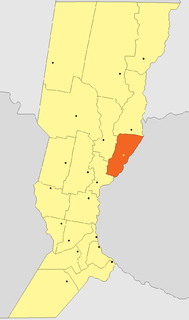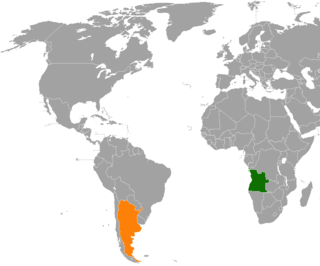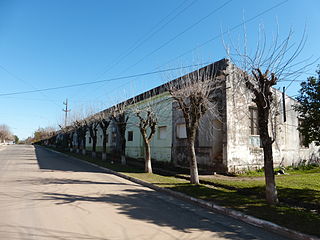
South America is a continent entirely in the Western Hemisphere and mostly in the Southern Hemisphere, with a relatively small portion in the Northern Hemisphere. It can also be described as the southern subregion of a single continent called America. The reference to South America instead of other cultural or geographical regions has increased in recent decades due to changing geopolitical dynamics.

Palm oil is an edible vegetable oil derived from the mesocarp of the fruit of the oil palms. The oil is used in food manufacturing, in beauty products, and as biofuel. Palm oil accounted for about 33% of global oils produced from oil crops in 2014.

Jerky is lean trimmed meat that has been cut into strips and dried (dehydrated) to prevent spoilage. Normally, this drying includes the addition of salt to prevent bacteria growth before the meat has finished the dehydrating process. The word "jerky" derives from the Quechua word ch'arki which means "dried, salted meat". All that is needed to produce basic "jerky" is a low-temperature drying method, and salt to inhibit bacterial growth.

Hallaca is a tamal from Venezuela. It consists of corn dough stuffed with a stew of beef, pork, or chicken and other ingredients such as raisins, capers, and olives. Hallacas are folded in plantain leaves, tied with strings, and boiled; The dish is traditionally served during the Christmas season and has several regional variants in Venezuela. It has been described as a national dish of Venezuela but it can be found also in variants. Some speculate it originated from the Orinoquia. A characteristic of the hallaca is the delicate corn dough made with consommé or broth and lard colored with annatto. Hallacas are also commonly consumed in eastern Cuba, Trinidad where it is referred to as pastelle, as well as parts of Colombia, Ecuador, Aruba, and Curaçao. In Nicaragua it is known as “Nacatamal”.

Pastoral farming is aimed at producing livestock, rather than growing crops. Examples include dairy farming, raising beef cattle, and raising sheep for wool. In contrast, arable farming concentrates on crops rather than livestock. Finally, mixed farming incorporates livestock and crops on a single farm. Some mixed farmers grow crops purely as fodder for their livestock; some crop farmers grow fodder and sell it. In some cases pastoral farmers are known as graziers, and in some cases pastoralists. Pastoral farming is a non-nomadic form of pastoralism in which the livestock farmer has some form of ownership of the land used, giving the farmer more economic incentive to improve the land. Unlike other pastoral systems, pastoral farmers are sedentary and do not change locations in search of fresh resources. Rather, pastoral farmers adjust their pastures to fit the needs of their animals. Improvements include drainage, stock tanks, irrigation and sowing clover.

Merlo is a partido of Buenos Aires Province, Argentina. It is located in Greater Buenos Aires, Argentina, west of the city of Buenos Aires. Its capital is the city of Merlo.

The Garay Department is an administrative subdivision (departamento) of the province of Santa Fe, Argentina. It is located in the center-east of the province. It has about 20,000 inhabitants as per the 2001 census [INDEC]. Its head town is the city of Helvecia. It is the least populated in the province.
The Saladoid culture is a pre-Columbian indigenous culture of territory in present-day Venezuela and the Caribbean that flourished from 500 BCE to 545 CE. The Saladoid were an Arawak people. Concentrated along the lowlands of the Orinoco River, the people migrated by sea to the Lesser Antilles, and then to Puerto Rico.
Le Gros et le maigre is a short silent, comic film written and directed by Roman Polanski in 1961. Polanski shot this short film just after graduating from The National Film School in Łódź in 1959; it was made in France and was Polanski's last film before the international breakthrough of his 1962 debut feature, Knife in the Water. The Fat and the Lean features the music of Krzysztof Komeda, who composed the scores for all but one of the director's films between Two Men and a Wardrobe (1958) and Rosemary's Baby (1968).

A pebete is an Argentine soft oval bun made of wheat flour with a thin brown crust, rather like a fatter hot dog roll. It is often used to make a sandwich, typically filled with cheese, cured meat, tomato and mayonnaise; the sandwich itself is usually called pebete followed by its filling, e.g., pebete de queso.

Mariano Cabal was the governor of the province of Santa Fe, Argentina between 9 April 1886 and 7 April 1871.
Afro-Argentines are Argentines of primarily Sub-Saharan African descent. The Afro-Argentine population is the result of being brought over during the transatlantic slave trade during the centuries of Spanish domination in the region, which had a major role in Argentine history. Although in recent years many descend from or are recent immigrants from Africa.

Falkland Islanders derive from various origins. Earliest among these are the numerically small but internationally diverse early 19th century inhabitants of the Falkland Islands, comprising and descended in part from settlers brought by Luis Vernet, and English and American sealers; South American gauchos who settled in the 1840s and 1850s; and since the late 1830s, settlers largely from Britain with a minority from other European countries. There has also been significant recent contributions from Saint Helena and Chile.

La Lechera or Leite Moça is a Nestlé brand, producing various dairy products. The brand was established in 1921 and markets its products in Latin America, Spain and also among Hispanic populations in the United States.

Bilateral relations between Argentina and India, have existed for decades. Argentina has an embassy in Delhi and a Consulate General in Mumbai whilst India has an embassy in Buenos Aires. Both countries are members of G20, Group of 24 and Group of 77.

Fried chicken, also known as Southern fried chicken is a dish consisting of chicken pieces that have been coated with seasoned flour or batter and pan-fried, deep fried, pressure fried, or air fried. The breading adds a crisp coating or crust to the exterior of the chicken while retaining juices in the meat. Broiler chickens are most commonly used.

Angola and Argentina are members of the Group of 77 and the United Nations.

The Economy of the Empire of Brazil was centered on export of raw materials when the country became independent in 1822. The domestic market was small, due to lack of credit and the almost complete self-sustainability of the cities, villages and farms that dedicated themselves to food production and cattle herding. During the first half of the 19th century, the Imperial Government invested heavily in the improvement of roads while retaining an excellent system of ports. The former facilitated better commercial exchange and communication between the country's distant regions; the latter did the same for foreign trade.

Pueblo Liebig is a village and municipality in Entre Ríos Province in north-eastern Argentina. This small town seduces tourists with its quiet pace, its recreational activities and a rich history.

Pedro Luro was born in Gamarthe, France, on March 10, 1820 and died in Cannes, France, on Feb 28, 1890. He immigrated to Argentina in 1837 and worked in a 'saladero,' a manufacturing facility designed to produce salted and dried meat, as a rural peasant and passenger. He was a proponent of Mar del Plata and of transitioning the territory of La Pampa into a province. Furthermore, he colonized lands in the middle and south of the Buenos Aires province until the Río Negro.

















